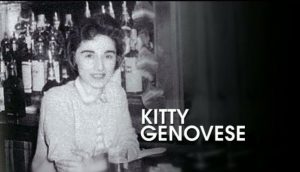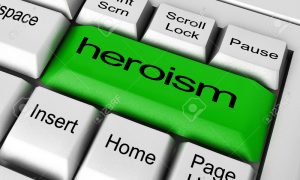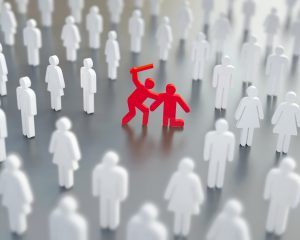 By Rick Hutchins and Scott T. Allison
By Rick Hutchins and Scott T. Allison
If you love heroes and desire to live in a more heroic society, there is no better time to be alive than right now. There is a clear and growing “heroism movement” brewing around the world, manifesting itself in hero conferences, hero activism, and hero research. Underlying each component of the heroism movement is the idea that we can all be heroes, that heroism is not reserved for the few, the special, the elite among us, but rather is within close reach of us all.
Close reach, however, does not mean easy reach.
This brings us to the concept of the “Almost Hero”. The Almost Hero is the person perched on the precipice of heroism, the individual who has heroic capability but doesn’t know it or who attempts to be heroic but just falls short.
In this essay, we consider three types of Almost Heroes.
First, there is the Almost hero who succumbs to the “bystander effect”, a phenomenon thrust into public consciousness after Kitty Genovese was murdered in 1964. For every instance of a heroic passerby coming to the aid of a person in peril, there is a corresponding tale of those who stand idly by and witness a crime or assault without intervening. It’s the classic case of the road not taken. In one timeline, a person is saved and a hero is made, while in the other there is tragedy for one and a missed opportunity for the other.
What factors decide which outcome prevails? Science has an answer. Studies have shown that people fail to help because they “diffuse responsibility”, which is one’s tendency to assume that other people should do the hard work of heroism instead of oneself.

Of course, Almost Heroism of this type does not apply to those who do not have the option of taking action; one cannot expect the elderly or the disabled to rush into a burning building or dive into a rushing river, nor even expect the average person to engage an overwhelming or armed assailant. Here we are strictly concerned with those who could have acted but for one reason or another failed to do so.
The bystander effect is a striking example of Almost Heroes choosing not to act when action is needed to save lives.
But what about Almost Heroes who do act but whose actions fall short? What are we to make of them?
This brings us to the second type of Almost Hero, the individual who rushes into a burning building to save someone but is overcome with smoke and must return to fresh air before successfully reaching the victim. Or the Almost Hero who attempts CPR on an unbreathing heart attack victim but cannot revive the person. Why should these failed attempts at heroism preclude them from achieving the status of hero?
These attempts are usually referred to as “heroic efforts” or “heroic measures,” acknowledging the intent and the struggle to avert disaster, even if the attempt falls short of success. In this case, the Almost Hero may be judged either generously or harshly by public opinion, depending on the particular circumstances surrounding the event, but the most unforgiving critic of a failed heroic attempt is almost invariably the Almost Hero himself.
But there is a third category of Almost Hero more tragic than either apathy or failure: What of those who sacrifice their own lives in their vain attempt to help another? Shortsighted people may condemn such people as foolhardy, but most of us know better. There is no nobler act than dying in the act of serving others, regardless of the ultimate outcome.
Yet because we live in a society that worships at the altar of the final outcome, this third type of Almost Hero is the most overlooked hero. Behavior speaks volumes. If someone puts herself in harm’s way to help others, she is a hero regardless of the outcome.
– – – – – – – –
We conclude with two caveats.
First, we should note that Zeno Franco, a renowned heroism scientist, has discussed the idea of “heroic failure”, which does NOT refer to the idea of a failed heroic attempt but rather to the idea of a failure to even try. Franco writes, “By heroic failure what is meant is not that someone  tried to be heroic and failed in the process, but rather that a leader’s heroic imagination failed, thus not allowing her to see the unfolding crisis events as requiring a heroic response.”
tried to be heroic and failed in the process, but rather that a leader’s heroic imagination failed, thus not allowing her to see the unfolding crisis events as requiring a heroic response.”
It is incumbent upon all of us to avoid heroic failure, to remain vigilant for opportunities to help others.
Second, we emphasize the benefits of helping others for both the helper and the recipient of helping. It really is a win-win situation. Obviously, the recipient stands much to gain; his or her life may be saved. But what good does helping do the helper?
Researchers have found that we benefit ourselves when we perform acts of kindness. Doing a good deed increases levels of oxytocin, a “cardioprotective” hormone that lowers blood pressure, decreases depression, and slows the aging process. Helping others has also been shown to increase optimism, moods, and relationship satisfaction.
So there you have it. Do not settle for Almost Heroism. Settle for nothing less than Full Throttle Heroism that not only benefits the helper and the helpee, but also benefits our entire society. Research has shown that kindness is contagious. We are inspired by tales of heroism, and your act of heroic kindness will produce a ripple effect that can forever alter the heroic mindset of generations to come.
References
Franco, Z. E. (2017). Heroism in Times of Crisis: Understanding Leadership During Extreme Events. In S. T. Allison, G. R. Goethals, & R. M. Kramer (Eds.), Handbook of heroism and heroic leadership. New York: Routledge.
– – – – – – – – – – – – – – –
This essay represents the first collaboration between Rick Hutchins and Scott Allison. Rick has worked in the health care field for the past twenty-five years, in various capacities. He is also the author of Large In Time, a collection of poetry, The RH Factor, a collection of short stories, and is the creator of Trunkards. Links to galleries of his art, photography and animation can be found on http://www.RJDiogenes.com.